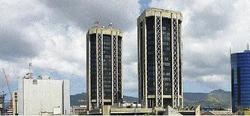Linda Hutchinson-Jafar, Business Writer

Trinidad's capital Port of Spain, the seat of goverment. Trinidad commentators want the Patrick Manning administration to take deciisive measures to rein in inflation, which was in above target at 7.6 per cent at December 2007. - File
The good times aren't quite at an end - far from it.
But Trinidadian commentators and analysts are warning of hiccups on the horizon: in the form of growing inflation, and somewhat paradoxically, a slowdown in the energy sector, whose earnings helped drive inflationary spending by the government in the first place.
So, the Patrick Manning administration, fresh from its third-term election victory, is hearing it all round, that it has to implement policies to rein in prices without undermining the country's robust energetic growth, which in 2007 recorded its second consecutive year of double digit expansion.
"An increase in the inflation rate pushes up manufacturers' production costs, and we then find ourselves having to charge more for the goods that we manufacture," warned Karen De Montbrun, president of the Trinidad and Tobago Manufacturers Association (TTMA).
"Rising inflation can, therefore, lead to a decline in manufacturers' competitiveness. The TTMA hopes that the Government follows through on its promise to take steps to address the root causes of inflation, including rising food prices," she added.
The latest data from the government's Central Statistical Office show that headline inflation stood at 7.6 per cent at the end of December 2007, against the administration's target of 7.0 per cent.
The outturn does nothing to reverse the trend of rising prices since the middle of the decade.
In fact, in 2003 headline inflation in Trinidad and Tobago was 3.0 per cent.
Heavy spending
According to Jwala Rambarran, the managing director of CAP-N Research a substantial cause of the spike in prices is that strong energy revenues enabled the government to spend heavily in physical and social infrastructure, widening the non-energy sector deficit, which is covered by the central bank.
The upshot is that part of the costs that Trinidadians have to pay for better roads, improved health care and wider access to education is higher prices - and concerns like those raised by TTMA's De Montbrun.
Rambarran argued that of all of the potential solutions available to the authorities to curtail the problem, one stands out as best - implementing tighter monetary controls by the central bank which he said should pull back on its coverage of non-energy sector deficits.
"It (the solution) recognises that inflation is, everywhere, a monetary phenomenon," he said.
"By financing the non-energy fiscal deficit, the central bank is basically validating price increases throughout the wider economy. Break this link and there is a very strong chance of curbing core inflationary pressures."
If the Government wants to fund its myriad of construction projects, Rambarran suggested, they should go to the capital markets, which will determine the appropriate risks and costs involved.
"If such fundamental reform is not implemented in 2008, citizens can assume - if they have not already done so - that the authorities are not really concerned about reducing inflation in T&T," he said.
Gervase Warner, executive chairman of Neal & Massy Energy Limited, like Trinidadian analysts, largely agrees the three major drivers of inflation are increased government spending facilitated by increased oil and gas revenues; the escalation in food prices; and inflated wages in the construction and energy sector.
Yet the energy sector faces at this time the conundrum of contradictory policy objectives.
It needs to attract investment in the upstream sector and boost proven gas reserve so as to increase domestic gas-based petrochemicals production and further develop industries like steel and aluminium.
At the same time there is the need to forestall rising inflation caused from oil and gas revenues.
"We've had a drop-off in exploration activity at the very time we need to increase it," Warner said.
Little exploration activity
" ... Around 2005, 2006 we had an unsuccessful ... bid rounds for new off-shore blocks and that's resulted in not as much exploration activity. In an energy-based economy that's bad."
Natural gas production for January to September 2007 averaged at 4.04 billion cubic feet of gas a day or approximately 1.48 trillion cubic feet of natural gas production over the nine months.
At the same time, oil production in the same period was a disappointing 121,738 barrels per day, a 14.3 per cent decline over the average oil production in 2006 of 142,753 bpd.
Confidence has further been tested by the finding of a recent audit of the country's natural gas reserves, which placed proven reserves at 9.2 per cent below the estimate over the period 2005 to 2007; while the 3Ps (proven, possible, probable) reserve declined by 11 per cent over the same period.

